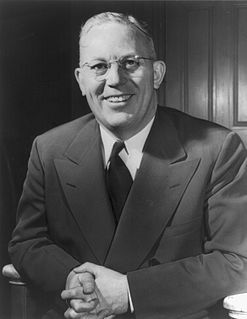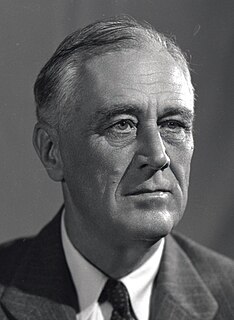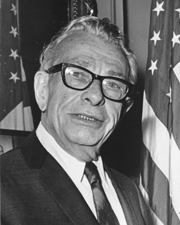
The 1944 United States presidential election was the 40th quadrennial presidential election. It was held on Tuesday, November 7, 1944. The election took place during World War II. Incumbent Democratic President Franklin D. Roosevelt defeated Republican Thomas E. Dewey to win an unprecedented fourth term.

The 1948 United States presidential election was the 41st quadrennial presidential election. It was held on Tuesday, November 2, 1948. Incumbent President Harry S. Truman, the Democratic nominee, defeated Republican Governor Thomas E. Dewey. Truman's victory is considered to be one of the greatest election upsets in American history.

The 1952 United States presidential election was the 42nd quadrennial presidential election. It was held on Tuesday, November 4, 1952. Republican Dwight D. Eisenhower won a landslide victory over Democrat Adlai Stevenson, ending a string of Democratic Party wins that stretched back to 1932.

The 1948 Republican National Convention was held at the Municipal Auditorium, in Philadelphia, Pennsylvania, from June 21 to 25, 1948.
The America First Party was an isolationist political party which was founded on January 10, 1943. Its leader, Gerald L. K. Smith, was the party's presidential candidate in the 1944 U.S. presidential election.

The 1944 Democratic National Convention was held at the Chicago Stadium in Chicago, Illinois from July 19 to July 21, 1944. The convention resulted in the nomination of President Franklin D. Roosevelt for an unprecedented fourth term. Senator Harry S. Truman of Missouri was nominated for Vice President. Including Roosevelt's nomination for the vice-presidency in 1920, it was the fifth time Roosevelt had been nominated on a national ticket. The keynote address was given by Governor Robert S. Kerr of Oklahoma, in which he "gave tribute to Roosevelt's war leadership and new deal policies."
Presidential primaries have been held in the United States since 1912 to nominate the Republican presidential candidate.

The 1952 Republican presidential primaries were the selection process by which voters of the Republican Party chose its nominee for President of the United States in the 1952 U.S. presidential election. Former U.S. Army General Dwight D. Eisenhower was selected as the nominee through a series of primary elections and caucuses culminating in the 1952 Republican National Convention held from July 7 to July 11, 1952, in Chicago, Illinois.

The 1948 Republican presidential primaries were the selection process by which voters of the Republican Party chose its nominee for President of the United States in the 1948 U.S. presidential election. The nominee was selected through a series of primary elections and caucuses culminating in the 1948 Republican National Convention held from June 21 to June 25, 1948, in Philadelphia, Pennsylvania.

The 1944 Republican presidential primaries were the selection process by which voters of the Republican Party chose its nominee for President of the United States in the 1944 U.S. presidential election. The nominee was selected through a series of primary elections and caucuses culminating in the 1944 Republican National Convention held from June 26 to June 28, 1944, in Chicago, Illinois.

The 1944 United States presidential election in New York took place on November 7, 1944. All contemporary 48 states were part of the 1944 United States presidential election. New York voters chose 47 electors to the Electoral College, which selected the president and vice president.

The 1944 United States presidential election in Massachusetts took place on November 7, 1944, as part of the 1944 United States presidential election, which was held throughout all contemporary 48 states. Voters chose sixteen representatives, or electors to the Electoral College, who voted for president and vice president.

The 1948 United States presidential election in Vermont took place on November 2, 1948, as part of the 1948 United States presidential election which was held throughout all contemporary 48 states. Voters chose three representatives, or electors to the Electoral College, who voted for president and vice president.

The 1944 United States presidential election in Vermont took place on November 7, 1944, as part of the 1944 United States presidential election which was held throughout all 48 states. Voters chose three representatives, or electors to the Electoral College, who voted for president and vice president.

The 1944 United States presidential election in New Jersey took place on November 7, 1944. All contemporary 48 states were part of the 1944 United States presidential election. New Jersey voters chose 16 electors to the Electoral College, which selected the president and vice president.

The 1952 United States presidential election in New Hampshire took place on November 4, 1952, as part of the 1952 United States presidential election, which was held throughout all contemporary 48 states. Voters chose 4 representatives, or electors to the Electoral College, who voted for president and vice president.

The 1948 United States presidential election in New Hampshire took place on November 2, 1948, as part of the 1948 United States presidential election, which was held throughout all contemporary 48 states. Voters chose four representatives, or electors to the Electoral College, who voted for president and vice president.

This article lists those who were potential candidates for the Republican nomination for Vice President of the United States in the 1952 election. After defeating Ohio Senator Robert A. Taft for the Republican presidential nomination at the 1952 Republican National Convention, General Dwight D. Eisenhower needed to choose a running mate. Taft recommended Illinois Senator Everett Dirksen, but Eisenhower rejected the suggestion. Eisenhower and his advisers put together a list of prominent Republicans who were acceptable to both the conservative Taft and liberal Dewey wings of the party, anti-Communist, talented at campaigning, relatively young, and who contributed to Eisenhower's nomination victory. After conferring with Republican Party leaders, Eisenhower decided to ask California Senator Richard Nixon to be his running mate; Nixon accepted the offer. Nixon had carefully campaigned for the post of vice president since meeting Eisenhower in 1951, and Nixon helped deliver the California delegation to Eisenhower in the presidential ballot. The Republican convention ratified Eisenhower's choice of Nixon. Months after the convention, Eisenhower considered asking Nixon to step down as running mate due to controversy surrounding campaign expenses, but Nixon rallied public opinion with his Checkers speech and remained on the ticket. The Eisenhower-Nixon ticket won the 1952 election, as well as the 1956 election, defeating the Stevenson-Sparkman and Stevenson-Kefauver tickets, respectively.

This article lists those who were potential candidates for the Republican nomination for Vice President of the United States in the 1948 election. After New York Governor Thomas Dewey secured the Republican presidential nomination on the third ballot of the 1948 Republican National Convention, the convention needed to choose Dewey's running mate. Dewey and several party leaders discussed Dewey's running mate during the evening of June 24. House Majority Leader Charles A. Halleck and former Minnesota Governor Harold Stassen were both considered, but Dewey ultimately decided to ask California Governor Earl Warren to serve as his running mate. Warren had earlier said that he would not accept the position, and asked for time to consider the offer. In the meantime, Stassen was asked to serve as running mate if Warren declined. However, Dewey convinced the reluctant Warren to join his ticket. Halleck alleged that he had been promised the vice presidency in exchange for supporting Dewey, but Halleck's isolationism convinced Dewey and others to pass him over. The Dewey-Warren ticket was well-received by the press, as it combined the youthful, popular governors of two of the three most populous states in the nation. Despite being favored by most, the Dewey-Warren ticket lost the 1948 election to the Democratic Harry S. Truman-Alben W. Barkley ticket. In 1953, Warren was appointed Chief Justice of the United States by President Dwight D. Eisenhower.



















